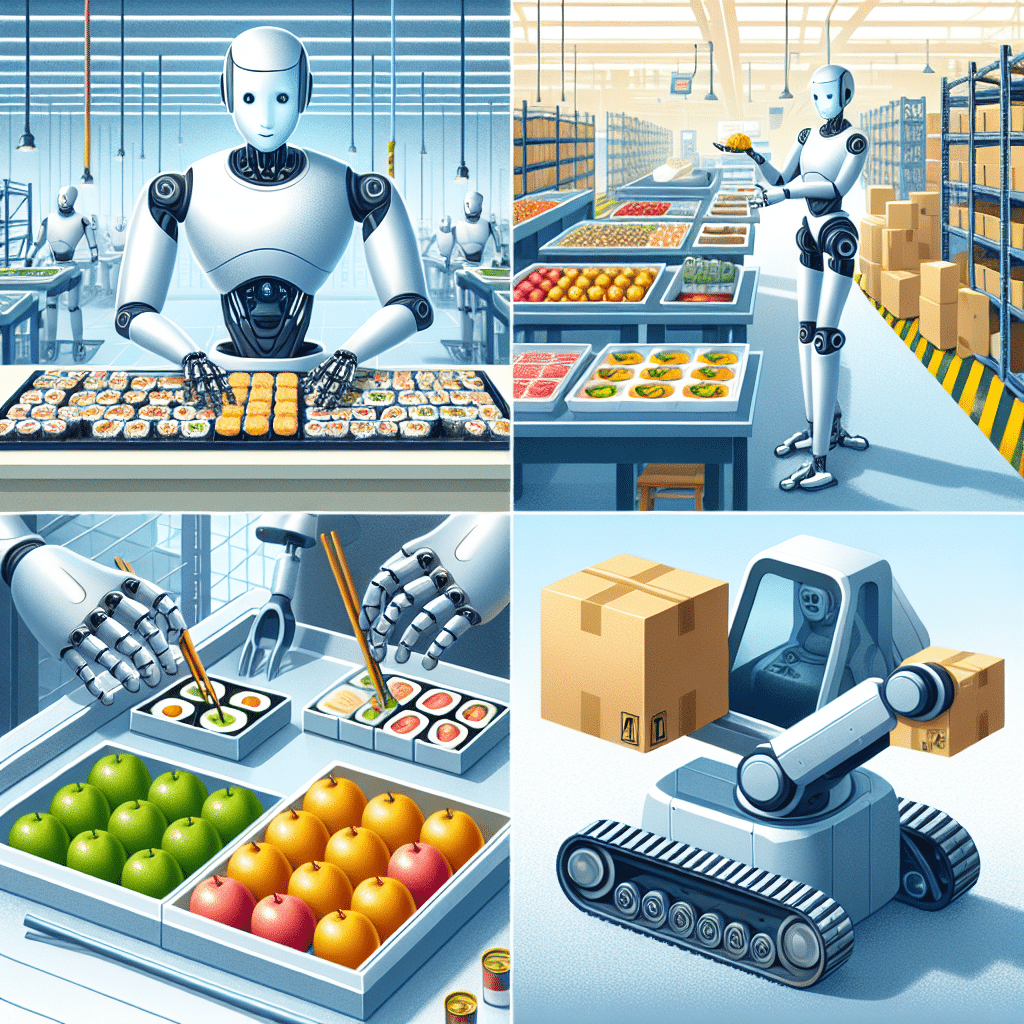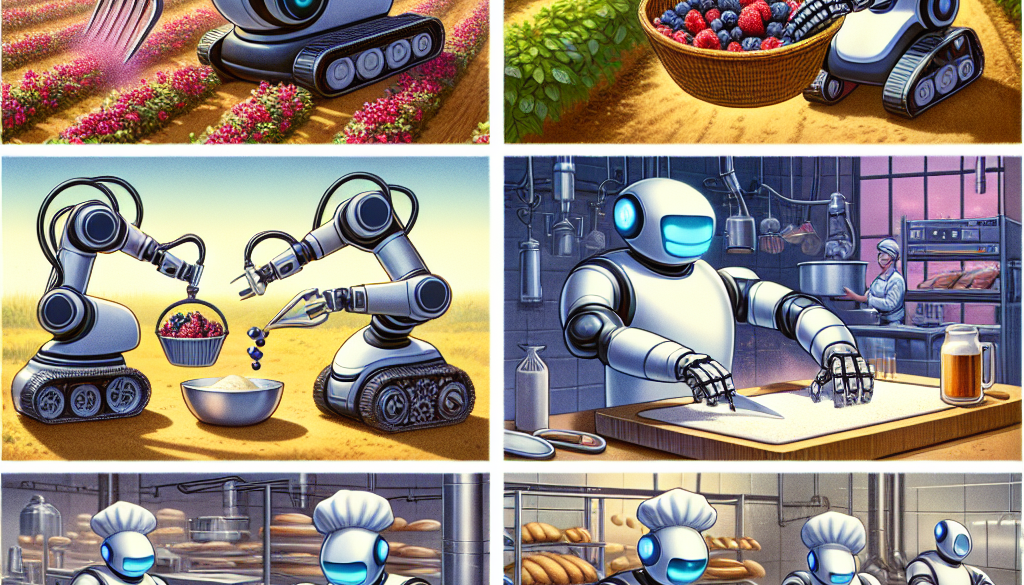Kinds Of Robots In Food Producing
-
Table of Contents
- Exploring the Various Robots Revolutionizing Food Production
- Robots in Agriculture: Sowing the Seeds of Innovation
- Robots in Food Processing: Enhancing Efficiency and Hygiene
- Robots in Food Service: Serving Up the Future
- Conclusion: The Robotic Revolution in Food Production
- Enhance Your Food Production with ETprotein’s High-Quality Protein Products
Exploring the Various Robots Revolutionizing Food Production

The food industry is undergoing a significant transformation, with robotics playing a pivotal role in enhancing efficiency, safety, and sustainability. The integration of robots in food production is not just a futuristic concept but a present-day reality that is reshaping the way we produce and process food. This article delves into the different kinds of robots that are making waves in the food-producing sector, highlighting their functionalities and the benefits they bring to the table.
Robots in Agriculture: Sowing the Seeds of Innovation
Robotic technology in agriculture, often referred to as agribots, is revolutionizing traditional farming practices. These robots are designed to handle a variety of tasks that are labor-intensive and time-consuming. Here are some of the key types of robots used in agriculture:
- Autonomous Tractors: These self-driving tractors can plow, till, and sow seeds with precision, reducing the need for manual labor and increasing productivity.
- Harvesting Robots: Equipped with advanced sensors and AI, these robots can identify ripe produce and harvest it without damaging the crops or the surrounding plants.
- Weeding Robots: These robots use computer vision to differentiate between crops and weeds, allowing them to remove unwanted plants without the use of harmful herbicides.
- Drones: Unmanned aerial vehicles (UAVs) are used for crop monitoring, spraying pesticides, and even planting seeds in hard-to-reach areas.
According to a report by MarketsandMarkets, the agricultural robots market is expected to grow from USD 4.1 billion in 2020 to USD 7.1 billion by 2025, at a CAGR of 12.2% during the forecast period. This growth is indicative of the increasing adoption of robotics in agriculture.
Robots in Food Processing: Enhancing Efficiency and Hygiene
The food processing industry is another area where robots are making significant inroads. Here are some of the robots that are commonly used:
- Picking and Packing Robots: These robots can sort, pick, and package food items at high speeds, far surpassing human capabilities, while maintaining consistency and hygiene.
- Butchery Robots: With precision cutting tools, these robots can slice and dice meat products with accuracy, reducing waste and improving worker safety.
- Bakery Robots: From mixing ingredients to decorating cakes, bakery robots can perform a range of tasks, ensuring uniformity and quality in baked goods.
- Quality Control Robots: Equipped with advanced imaging and sensor technology, these robots can detect imperfections or contaminants in food products, ensuring only the highest quality items are shipped out.
As per the Robotics Industries Association, food and consumer goods industries saw a 56% increase in robot orders in the first quarter of 2021 compared to the same period in 2020, demonstrating the growing reliance on robotic solutions.
Robots in Food Service: Serving Up the Future
Robots are not just limited to food production and processing; they are also making their way into food service. Here are some innovative examples:
- Cooking Robots: These robots can prepare entire meals, from flipping burgers to cooking noodles, ensuring consistency and speed in fast-food restaurants.
- Barista Robots: Capable of making a variety of coffee drinks, these robots can manage high-volume orders with precision and without fatigue.
- Waiter Robots: These service robots can deliver food to tables, interact with customers, and even sing birthday songs, enhancing the dining experience.
- Sanitizing Robots: In the wake of the COVID-19 pandemic, robots that can sanitize surfaces and dining areas have become increasingly important for maintaining health and safety standards.
The global food robotics market is projected to reach USD 3.1 billion by 2025 from an estimated USD 1.9 billion in 2020, at a CAGR of 11.6% during the forecast period, according to a report by ResearchAndMarkets.com.
Conclusion: The Robotic Revolution in Food Production
The integration of robots in food production is not just enhancing operational efficiencies but also addressing challenges such as labor shortages, food safety, and the need for sustainable practices. From the fields to the kitchen, robots are becoming an indispensable part of the food industry, promising a future where food is produced with greater precision, safety, and sustainability.
As we continue to witness the growth of robotics in food production, it is clear that this technology is here to stay, transforming the way we grow, process, and serve food. The key takeaways from this exploration are the versatility of robots in various food production sectors, the significant investment in robotic technology, and the positive impact on productivity and safety.
Enhance Your Food Production with ETprotein’s High-Quality Protein Products
If you’re in the food production industry and looking to incorporate high-quality protein ingredients into your products, ETprotein offers a range of organic bulk vegan proteins and L-(+)-Ergothioneine (EGT) that can meet your needs. Their products are characterized by a neutral taste, non-GMO, allergen-free attributes, and high purity levels, making them an excellent choice for a variety of applications.
About ETprotein:
ETprotein, a reputable protein and L-(+)-Ergothioneine (EGT) Chinese factory manufacturer and supplier, is renowned for producing, stocking, exporting, and delivering the highest quality organic bulk vegan proteins and L-(+)-Ergothioneine. They include Organic rice protein, clear rice protein, pea protein, clear pea protein, watermelon seed protein, pumpkin seed protein, sunflower seed protein, mung bean protein, peanut protein, and L-(+)-Ergothioneine EGT Pharmaceutical grade, L-(+)-Ergothioneine EGT food grade, L-(+)-Ergothioneine EGT cosmetic grade, L-(+)-Ergothioneine EGT reference grade and L-(+)-Ergothioneine EGT standard. Their offerings, characterized by a neutral taste, non-GMO, allergen-free attributes, with L-(+)-Ergothioneine purity over 98%, 99%, cater to a diverse range of industries. They serve nutraceutical, pharmaceutical, cosmeceutical, veterinary, as well as food and beverage finished product distributors, traders, and manufacturers across Europe, USA, Canada, Australia, Thailand, Japan, Korea, Brazil, and Chile, among others.
ETprotein specialization includes exporting and delivering tailor-made protein powder and finished nutritional supplements. Their extensive product range covers sectors like Food and Beverage, Sports Nutrition, Weight Management, Dietary Supplements, Health and Wellness Products, and Infant Formula, ensuring comprehensive solutions to meet all your protein needs.
As a trusted company by leading global food and beverage brands and Fortune 500 companies, ETprotein reinforces China’s reputation in the global arena. For more information or to sample their products, please contact them and email sales(at)ETprotein.com today.












